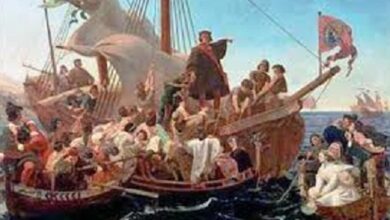The conquest of Mexico Characteristics Causes consequences Characters
Conquest of Mexico
Occupation by force of the Mexican State or Aztec Empire by Spanish conquerors. In this article we will give you the details of the Causes and consequences of conquest of Mexico.
It is usually called “Conquest of Mexico” to the occupation by force of the Mexican State or Aztec Empire by Spanish conquerors in the first decades of the 16th century as part of the conquest of America . However, the conquest of the territory currently occupied by the Mexican State was completed with successive subsequent campaigns that occupied the Yucatan peninsula to the south and the region north of the Mexican highlands.
The conquest of the Aztec Empire took place between 1519 and 1521, when Hernán Cortés , commanding a group of poorly armed troops joined by indigenous populations at odds with the Aztecs, managed to subdue it.
Enhance your reading: What was the gulf war about/historical context/development
Characteristics of the conquest of Mexico
The main characteristics of the conquest of Mexico were:
- The expedition of conquest left Cuba , under the command of Hernán Cortés , on February 10, 1519 . Expeditions in previous years had confirmed the existence of a Confederate empire dominated by the Aztecs, as well as the existence of enormous wealth in precious metals .
- The expedition consisted of 11 ships . In April 1519 he arrived in Veracruz where he stayed for 4 months. From there, Cortés broke relations with Diego Velázquez, governor of Cuba and sent a ship to Spain in order to obtain the documents that would allow him to legalize his situation. In addition, he made contact with indigenous people who were estranged from the Aztecs and added them to his troops. In August, he began the march to Tenochtitlan , the capital of the Aztec empire.
- In November of that year, Emperor Moctezuma received the Spanish in Tenochtitlán, but was taken prisoner. Although Cortés managed to enter the capital, his intransigence with religious questions made him hostile to the Aztec priests. On June 20, 1520, a popular uprising forced the Spanish to flee the city. This episode is known as ” the sad night .”
- Cortés managed to gather his troops and reorganize them thanks to the alliance with the Tlaxcalans , neighbors of the Aztecs and fierce enemies. With that Spanish support and reinforcements , in December of that year the siege of the city of Tenochtitlán began both by land and by water since the city was located in a lagoon.
- On August 12, 1521 , exhausted by hunger and disease, the Aztecs surrendered the city to Cortés. In this way, the empire fell into the hands of the Spanish conquerors.
Causes and consequences of the conquest of Mexico
Causes
The main causes of the conquest of Mexico were the following:
- The economic exhaustion and the depopulation of the Antilles that prompted the Spaniards to advance on new territories to obtain labor and the wealth that they had not found in the islands.
- The search for social advancement of the conquerors, many of them unfortunate nobles who embarked for America to obtain social recognition and wealth.
- The desire of the Spanish Crown to take effective possession of the lands discovered in the voyages of exploration.
- The will to convert the American populations to the Catholic religion .
Despite the numerical differences between the Americans and the Europeans, the conquest was facilitated by various factors:
- The differences in technological and tactical power between the troops of the Spanish conquerors and the Mexican armies. The Spanish had firearms and horses while the Americans used tactics and weapons that were ineffective against the Europeans.
- The subjugation of the populations of the region by the Aztec Empire . These populations saw in the alliance with the Spanish the possibility of defeating their enemy and participated together with them in the conquest of the Aztec Empire.
- The beliefs of the American peoples . Mythological narratives affirmed that the arrival of blond men (incarnations of Quetzalcoatl) would mark the end of an era.
Enhance your reading: Art deco features architecture and representatives in detail
Consequences
The main consequences of the conquest of Mexico were the following:
- The disappearance of the Aztec Empire . This was replaced by Spanish social and political structures that would lead a few years later to the formation of the Viceroyalty of New Spain .
- The occupation of the land by conquerors and settlers and the reduction to servitude of many aborigines.
- The elimination of indigenous religions and their replacement by the Catholic religion.
- The destruction of numerous cultural objects such as codices, sculptures, buildings, etc., which caused the loss of local knowledge and traditions.
- The demographic catastrophe caused by the death of hundreds of thousands of Native Americans from diseases, mistreatment and abuse by the conquerors.
- The beginning of a strong, albeit unbalanced, cultural exchange between the American and European settlers that included food, customs, language, etc.
Characters of the conquest of Mexico
The most relevant characters of the conquest of Mexico were.
- Hernán Cortés de Monroy y Pizarro Altamirano (1485-1547) : Spanish nobleman who carried out the conquest of Mexico.
- Moctezuma Xocoyotzin (1466-1520) : Aztec ruler upon the arrival of the Spanish. He died during a popular uprising.
- Cuauhtémoc (1496-1525) : last Aztec ruler, he was taken prisoner by Hernán Cortés and executed several years after the conquest of Tenochtitlán.
- Malintzin (Doña Marina or Malinche): Nahua woman given as a tribute to Hernán Cortés, was an interpreter and intermediary between the conqueror and the indigenous people.
